Device for Measuring Contact Reaction Forces during Animal Adhesion Landing/Takeoff from Leaf-like Compliant Substrates
Abstract
1. Introduction
2. Materials and Methods
2.1. Components of the Device
2.2. Simulation of Compliant Substrates
2.3. Measurement of Contact Force on Leaf-like Compliant Substrates
2.4. Experimental and Analytical Methods
2.4.1. Adhesive Contact Test Calibration
2.4.2. Animal Landing and Takeoff Experiment
3. Results and Discussion
3.1. Adhesive Contact Test Calibration Results
3.2. Contact Forces of Adhesion Landing/Takeoff from Leaf-like Compliant Substrates
3.2.1. Landing
3.2.2. Takeoff
3.3. Performance Comparisons and Limitations
4. Conclusions
Author Contributions
Funding
Institutional Review Board Statement
Data Availability Statement
Acknowledgments
Conflicts of Interest
References
- Gilman, C.A.; Irschick, D.J. Foils of Flexion: The Effects of Perch Compliance on Lizard Locomotion and Perch Choice in the Wild. Funct. Ecol. 2013, 27, 374–381. [Google Scholar] [CrossRef]
- Hunt, N.H.; Jinn, J.; Jacobs, L.F.; Full, R.J. Acrobatic Squirrels Learn to Leap and Land on Tree Branches without Falling. Science 2021, 373, 697–700. [Google Scholar] [CrossRef] [PubMed]
- Brown, C.E.; Deban, S.M. Jumping in Arboreal Salamanders: A Possible Tradeoff between Takeoff Velocity and in-Air Posture. Zoology 2020, 138, 125724. [Google Scholar] [CrossRef]
- Harmon, L.L.; Jones, C.G. Competition and Community Structure in Diurnal Arboreal Geckos (Genus Phelsuma) in the Indian Ocean. Oikos 2007, 116, 1863–1878. [Google Scholar] [CrossRef]
- Grismer, L.L.; Wood, P.J.L.; Anuar, S.; Riyanto, A.; Ahmad, N.; Muin, M.A.; Sumontha, M.; Grismer, J.L.; Onn, C.K.; Quah, E.S.H.; et al. Systematics and Natural History of Southeast Asian Rock Geckos (Genus Cnemaspis Strauch, 1887) with Descriptions of Eight New Species from Malaysia, Thailand, and Indonesia. Zootaxa 2014, 3880, 1. [Google Scholar] [CrossRef]
- Irschick, D.J.; Vanhooydonck, B.; Herrel, A.; Meyers, J. Intraspecific Correlations among Morphology, Performance and Habitat Use within a Green Anole Lizard (Anolis carolinensis) Population. Biol. J. Linn. Soc. 2005, 85, 211–221. [Google Scholar] [CrossRef][Green Version]
- Irschick, D.J.; Losos, J.B. Do Lizards Avoid Habitats in Which Performance Is Submaximal? The Relationship between Sprinting Capabilities and Structural Habitat Use in Caribbean Anoles. Am. Nat. 1999, 154, 293–305. [Google Scholar] [CrossRef]
- Spezzano, L.C.; Jayne, B.C. The Effects of Surface Diameter and Incline on the Hindlimb Kinematics of an Arboreal Lizard (Anolis sagrei). J. Exp. Biol. 2004, 207, 2115–2131. [Google Scholar] [CrossRef]
- Vanhooydonck, B.; Herrel, A.; Irschick, D.J. Out on a Limb: The Differential Effect of Substrate Diameter on Acceleration Capacity in Anolis Lizards. J. Exp. Biol. 2006, 209, 4515–4523. [Google Scholar] [CrossRef][Green Version]
- Reynaga, C.M.; Eaton, C.E.; Strong, G.A.; Azizi, E. Compliant Substrates Disrupt Elastic Energy Storage in Jumping Tree Frogs. Integr. Comp. Biol. 2019, 59, 1535–1545. [Google Scholar] [CrossRef]
- Channon, A.J.; Günther, M.M.; Crompton, R.H.; D’Août, K.; Preuschoft, H.; Vereecke, E.E. The Effect of Substrate Compliance on the Biomechanics of Gibbon Leaps. J. Exp. Biol. 2011, 214, 687–696. [Google Scholar] [CrossRef] [PubMed]
- Donihue, C.M.; Herrel, A.; Fabre, A.-C.; Kamath, A.; Geneva, A.J.; Schoener, T.W.; Kolbe, J.J.; Losos, J.B. Hurricane-Induced Selection on the Morphology of an Island Lizard. Nature 2018, 560, 88–91. [Google Scholar] [CrossRef] [PubMed]
- Walker, S.E. Leaping Behavior of Pithecia Pithecia and Chiropotes Satanas in Eastern Venezuela. Am. J. Primatol. 2005, 66, 369–387. [Google Scholar] [CrossRef] [PubMed]
- Thorpe, S.K.S.; Holder, R.; Crompton, R.H. Orangutans Employ Unique Strategies to Control Branch Flexibility. Proc. Natl. Acad. Sci. USA 2009, 106, 12646–12651. [Google Scholar] [CrossRef] [PubMed]
- Schapker, N.M.; Chadwell, B.A.; Young, J.W. Robust Locomotor Performance of Squirrel Monkeys (Saimiri Boliviensis) in Response to Simulated Changes in Support Diameter and Compliance. J. Exp. Zool. Pt. A Ecol. Integr. Physiol. 2022, 337, 417–433. [Google Scholar] [CrossRef]
- Higham, T.E.; Russell, A.P.; Niklas, K.J. Leaping Lizards Landing on Leaves: Escape-Induced Jumps in the Rainforest Canopy Challenge the Adhesive Limits of Geckos. J. R. Soc. Interface 2017, 14, 20170156. [Google Scholar] [CrossRef]
- Boulinguez-Ambroise, G.; Dunham, N.; Phelps, T.; Mazonas, T.; Nguyen, P.; Bradley-Cronkwright, M.; Boyer, D.M.; Yapuncich, G.S.; Zeininger, A.; Schmitt, D.; et al. Jumping Performance in Tree Squirrels: Insights into Primate Evolution. J. Hum. Evol. 2023, 180, 103386. [Google Scholar] [CrossRef]
- Gilman, C.A.; Bartlett, M.D.; Gillis, G.B.; Irschick, D.J.; Rodela, T.M.; Esbaugh, A.J.; Weihrauch, D.; Veauvy, C.M.; McDonald, M.D.; Gilmour, K.M.; et al. Total Recoil: Perch Compliance Alters Jumping Performance and Kinematics in Green Anole Lizards (Anolis carolinensis). J. Exp. Biol. 2012, 215, 220–226. [Google Scholar] [CrossRef]
- Astley, H.C.; Haruta, A.; Roberts, T.J. Jumping Performance and Elastic Energy Recovery from Compliant Perches in Tree Frogs. J. Exp. Biol. 2015, 218, 3360–3363. [Google Scholar] [CrossRef]
- Bonser, R.H.C. Branching out in Locomotion: The Mechanics of Perch Use in Birds and Primates. J. Exp. Biol. 1999, 202, 1459–1463. [Google Scholar] [CrossRef]
- Schmitt, D. Forelimb Mechanics as a Function of Substrate Type during Quadrupedalism in Two Anthropoid Primates. J. Hum. Evol. 1994, 26, 441–457. [Google Scholar] [CrossRef]
- Demes, B.; Jungers, W.; Fleagle, J.; Wunderlich, R.; Richmond, B.; Lemelin, P. Body Size and Leaping Kinematics in Malagasy Vertical Clingers and Leapers. J. Hum. Evol. 1996, 31, 367–388. [Google Scholar] [CrossRef]
- Sinervo, B.; Losos, J.B. Walking the Tight Rope: Arboreal Sprint Performance among Sceloporus Occidentalis Lizard Populations. Ecology 1991, 72, 1225–1233. [Google Scholar] [CrossRef]
- Alexander, R.M. Elastic Mechanisms in Primate Locomotion. Z. Für Morphol. Anthropol. 1991, 78, 315–320. [Google Scholar] [CrossRef]
- Biewener, A.A.; Daley, M.A. Unsteady Locomotion: Integrating Muscle Function with Whole Body Dynamics and Neuromuscular Control. J. Exp. Biol. 2007, 210, 2949–2960. [Google Scholar] [CrossRef]
- Demes, B.; Jungers, W.L.; Gross, T.S.; Fleagle, J.G. Kinetics of Leaping Primates: Influence of Substrate Orientation and Compliance. Am. J. Phys. Anthropol. 1995, 96, 419–429. [Google Scholar] [CrossRef]
- Djelal, N.; Ouanane, A.; Boudouane, I.; Rezzoug, A. Measuring Ground Reaction Forces of Quadruped Robot. In Proceedings of the 2022 International Conference of Advanced Technology in Electronic and Electrical Engineering (ICATEEE), Constantine, Algeria, 26–27 November 2022; pp. 1–3. [Google Scholar]
- Sugimoto, T.; Toda, H.; Takahashi, H. 3D Printed Micro Force Plate for Measuring the Ground Reaction Force of a Fruit Fly. In Proceedings of the 2022 IEEE 35th International Conference on Micro Electro Mechanical Systems Conference (MEMS), Tokyo, Japan, 9–13 January 2022; pp. 703–705. [Google Scholar]
- Ichinohe, T.; Takahashi, H.; Fujita, Y. Force Plate Analysis of Ground Reaction Forces in Relation to Gait Velocity of Healthy Beagles. Am. J. Veter. Res. 2022, 83, 1–7. [Google Scholar] [CrossRef] [PubMed]
- Han, S.; Peng, H.; Sun, Q.; Venkatesh, S.; Chung, K.; Lau, S.C.; Zhou, Y.; Roy, V.A.L. An Overview of the Development of Flexible Sensors. Adv. Mater. 2017, 29, 1700375. [Google Scholar] [CrossRef] [PubMed]
- Costa, J.C.; Spina, F.; Lugoda, P.; Garcia-Garcia, L.; Roggen, D.; Munzenrieder, N. Flexible Sensors—From Materials to Applications. Technologies 2019, 7, 35. [Google Scholar] [CrossRef]
- Luo, Y.; Abidian, M.R.; Ahn, J.-H.; Akinwande, D.; Andrews, A.M.; Antonietti, M.; Bao, Z.; Berggren, M.; Berkey, C.A.; Bettinger, C.J.; et al. Technology Roadmap for Flexible Sensors. ACS Nano 2023, 17, 5211–5295. [Google Scholar] [CrossRef] [PubMed]
- Bonser, R.H.C.; Rayner, J.M.V. Measuring Leg Thrust Forces in the Common Starling. J. Exp. Biol. 1996, 199, 435–439. [Google Scholar] [CrossRef]
- Bonser, R.H.C.; Norman, A.P.; Rayner, J.M.V. Does Substrate Quality Influence Take-Off Decisions in Common Starlings?: Substrate Quality in Take-Off. Funct. Ecol. 1999, 13, 102–105. [Google Scholar] [CrossRef]
- Autumn, K.; Dittmore, A.; Santos, D.; Spenko, M.; Cutkosky, M. Frictional Adhesion: A New Angle on Gecko Attachment. J. Exp. Biol. 2006, 209, 3569–3579. [Google Scholar] [CrossRef] [PubMed]
- Jiang, Q.; Wang, Z.; Zhou, J.; Chen, W.; Dai, Z. Analysis of Reaction Force and Locomotor Behavior on Geckos in Time- and Frequency-Domain during Climbing on Vertical Substrates. J. Bionic. Eng. 2019, 16, 115–129. [Google Scholar] [CrossRef]
- Niklas, K.J. A Mechanical Perspective on Foliage Leaf Form and Function. New Phytol. 1999, 143, 19–31. [Google Scholar] [CrossRef]
- Niinemets, Ü.; Fleck, S. Petiole Mechanics, Leaf Inclination, Morphology, and Investment in Support in Relation to Light Availability in the Canopy of Liriodendron Tulipifera. Oecologia 2002, 132, 21–33. [Google Scholar] [CrossRef] [PubMed]
- Niklas, K.J. Flexural Stiffness Allometries of Angiosperm and Fern Petioles and Rachises: Evidence for Biomechanical Convergence. Evolution 1991, 45, 734–750. [Google Scholar] [CrossRef]
- Ennos, A.; Spatz, H.; Speck, T. The Functional Morphology of the Petioles of the Banana, Musa Textilis. J. Exp. Bot. 2000, 51, 2085–2093. [Google Scholar] [CrossRef]
- Niklas, K.J.; Cobb, E.D.; Niinemets, Ü.; Reich, P.B.; Sellin, A.; Shipley, B.; Wright, I.J. “Diminishing Returns” in the Scaling of Functional Leaf Traits across and within Species Groups. Proc. Natl. Acad. Sci. USA 2007, 104, 8891–8896. [Google Scholar] [CrossRef]
- Lauderbaugh, L.K.; Holder, C.D. The Biomechanics of Leaf Oscillations during Rainfall Events. J. Exp. Bot. 2022, 73, 1139–1154. [Google Scholar] [CrossRef]
- Lindemuth, J. The Effect of Air Resistance on Falling Balls. Am. J. Phys. 1971, 39, 757–759. [Google Scholar] [CrossRef]
- Parker, G.W. Projectile Motion with Air Resistance Quadratic in the Speed. Am. J. Phys. 1977, 45, 606–610. [Google Scholar] [CrossRef]
- Heepe, L.; Xue, L.; Gorb, S.N. Bio-Inspired Structured Adhesives; Springer: Berlin/Heidelberg, Germany; New York, NY, USA, 2017; ISBN 978-3-319-59113-1. [Google Scholar]
- Jiang, Q.; Wang, L.; Weng, Z.; Wang, Z.; Dai, Z.; Chen, W. Effect of the Structural Characteristics on Attachment-Detachment Mechanics of a Rigid-Flexible Coupling Adhesive Unit. Biomimetics 2022, 7, 119. [Google Scholar] [CrossRef] [PubMed]
- Jin, K.; Tian, Y.; Erickson, J.S.; Puthoff, J.; Autumn, K.; Pesika, N.S. Design and Fabrication of Gecko-Inspired Adhesives. Langmuir 2012, 28, 5737–5742. [Google Scholar] [CrossRef]
- Zhou, M.; Tian, Y.; Pesika, N.; Zeng, H.; Wan, J.; Meng, Y.; Wen, S. The Extended Peel Zone Model: Effect of Peeling Velocity. J. Adhes. 2011, 87, 1045–1058. [Google Scholar] [CrossRef]
- Bijma, N.N.; Gorb, S.N.; Kleinteich, T. Landing on Branches in the Frog Trachycephalus Resinifictrix (Anura: Hylidae). J. Comp. Physiol. A 2016, 202, 267–276. [Google Scholar] [CrossRef]
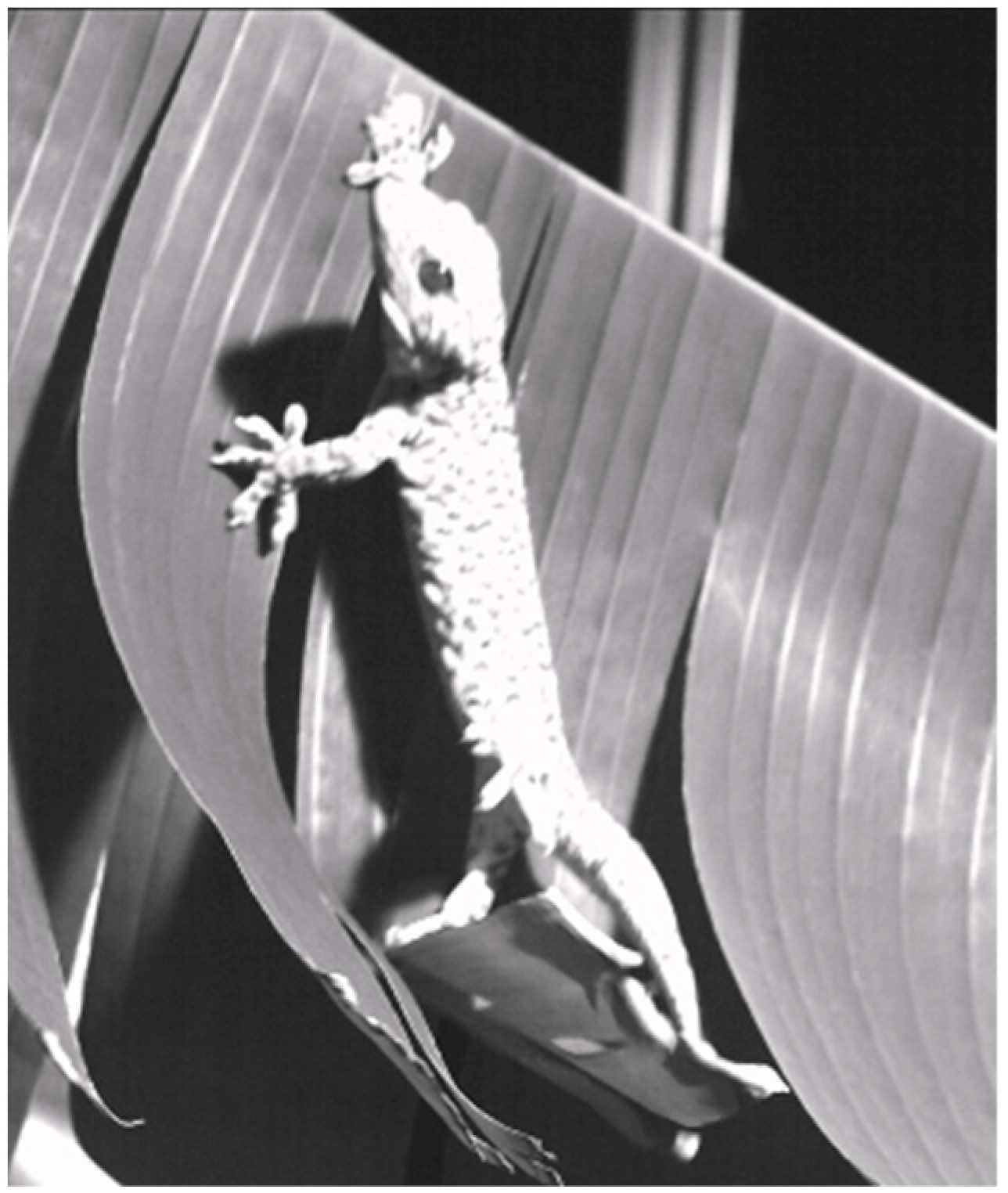
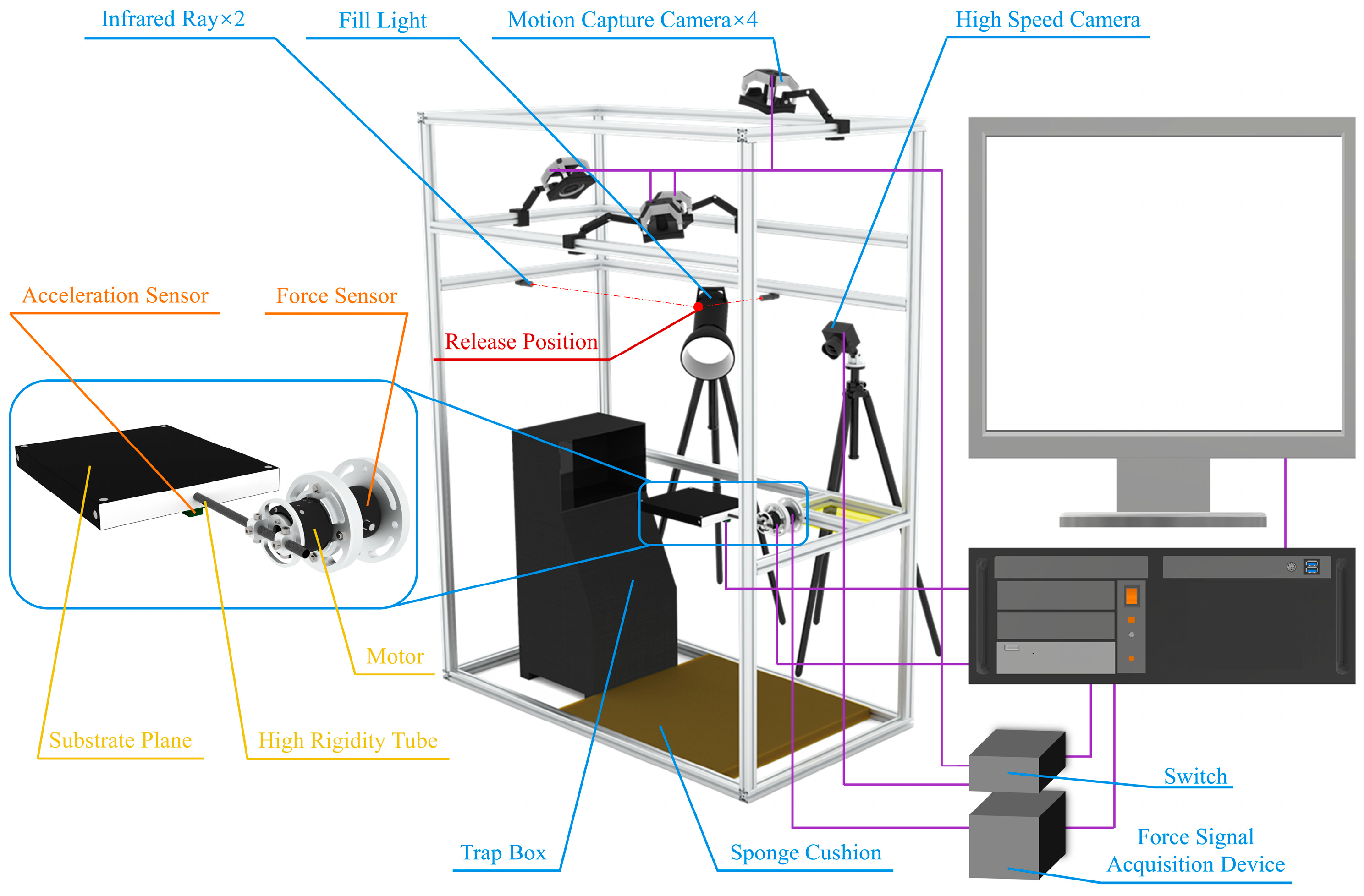
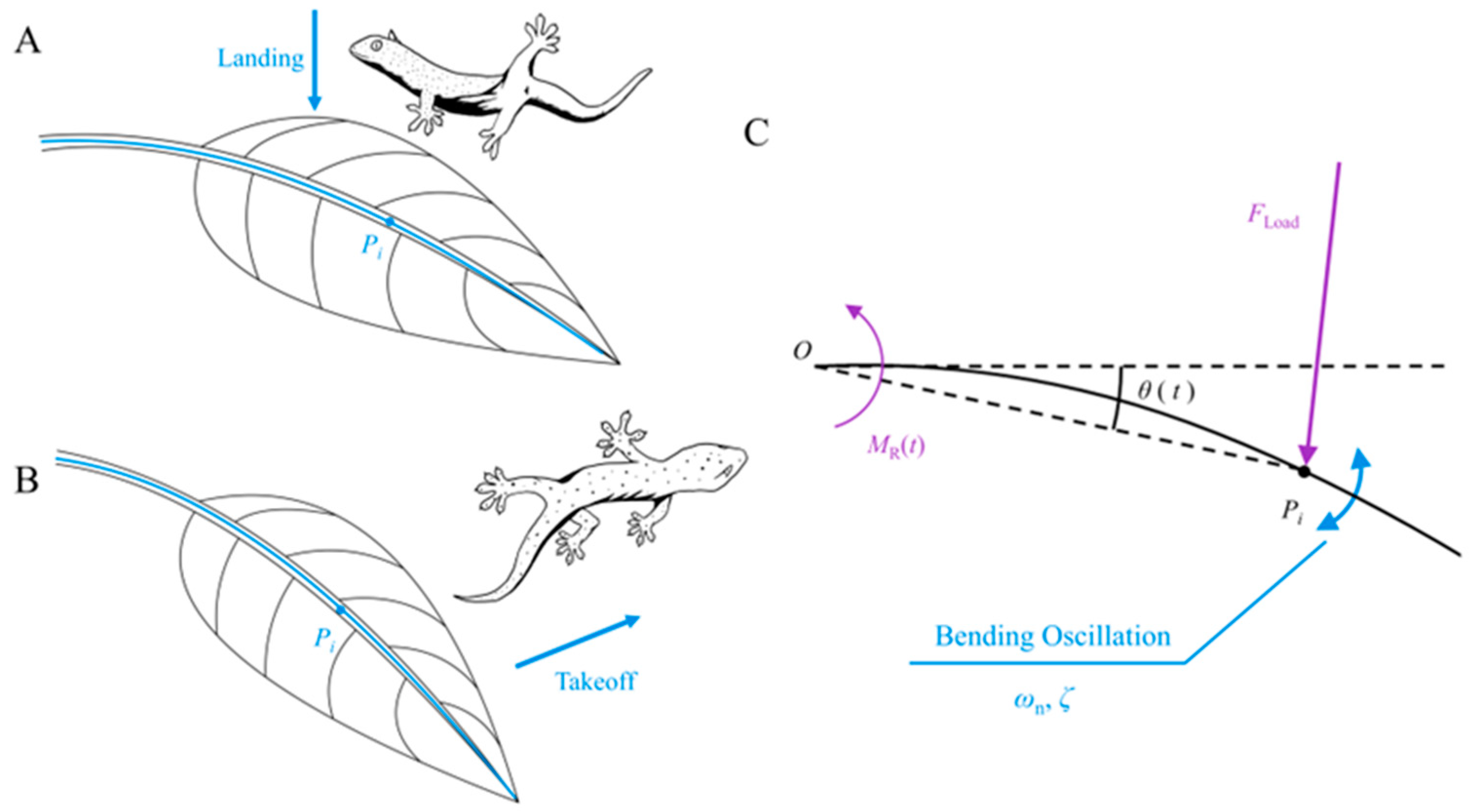
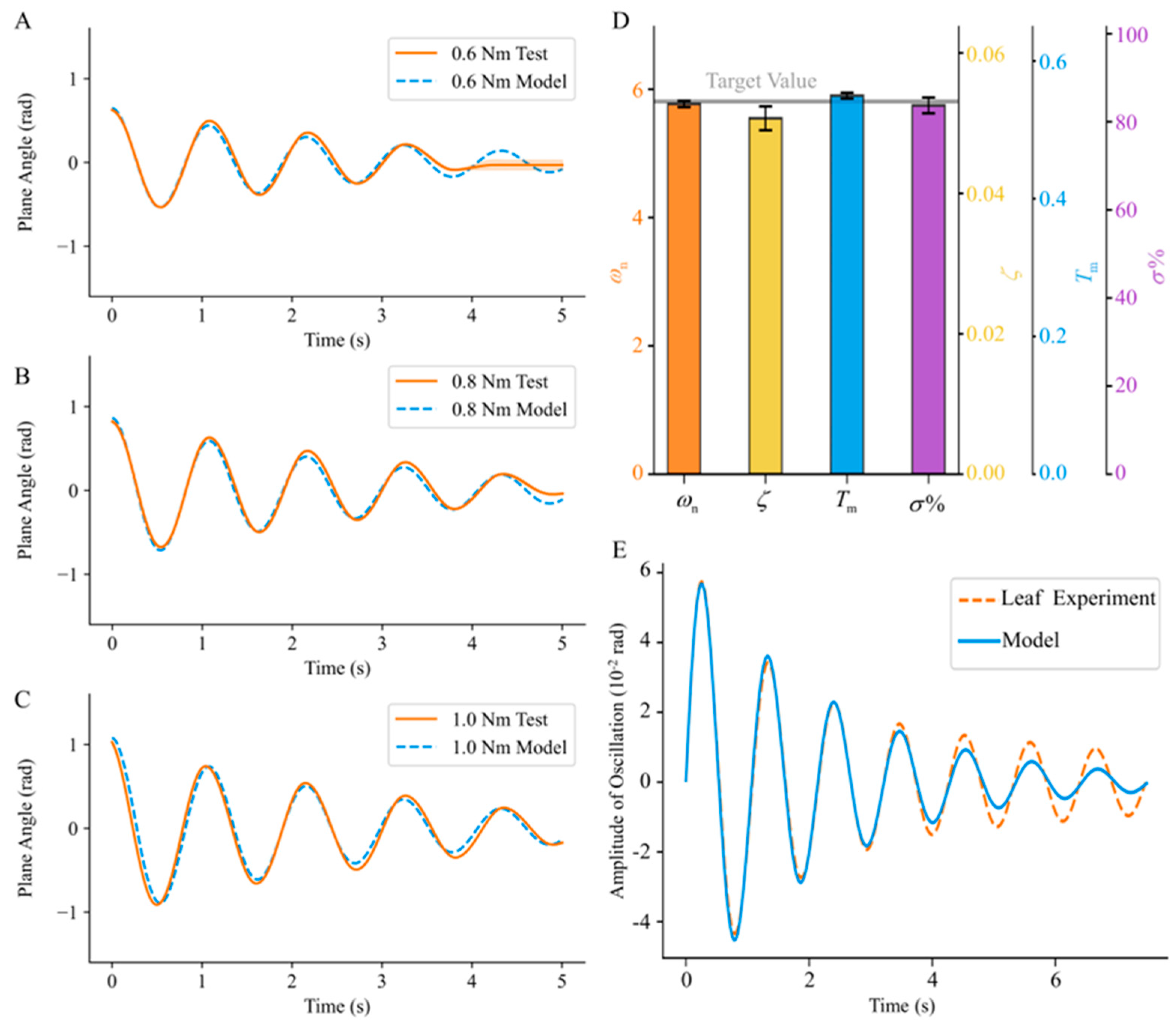
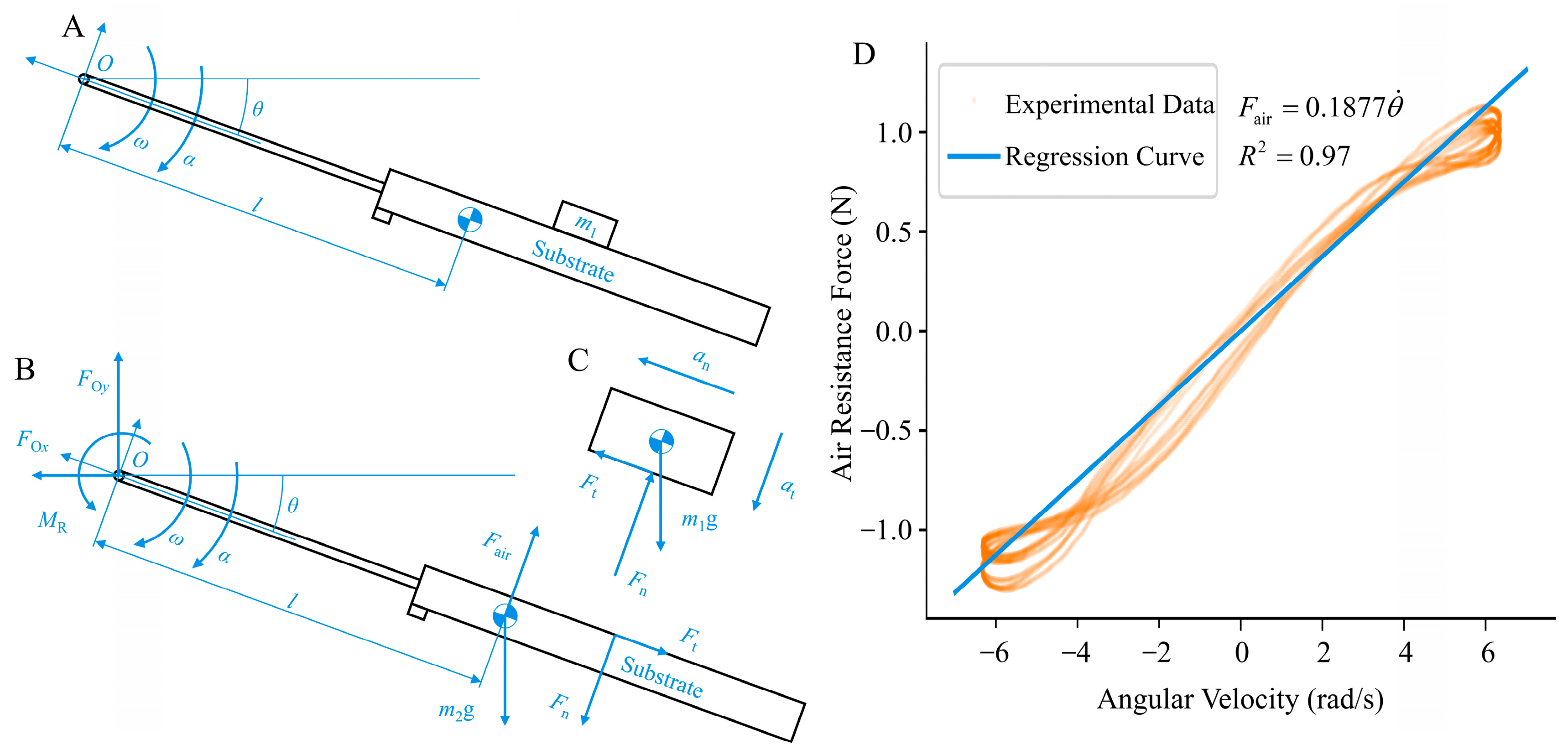
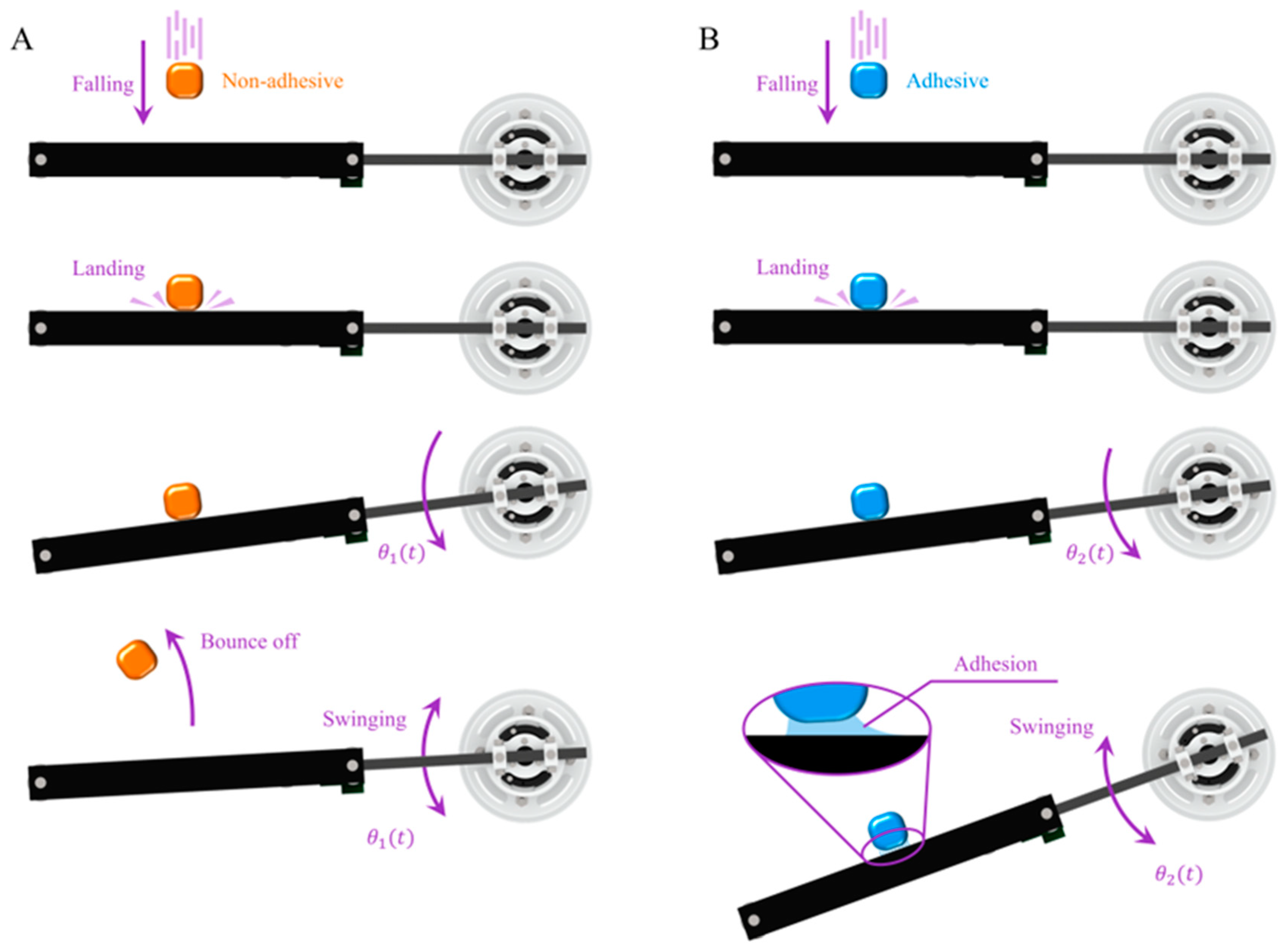

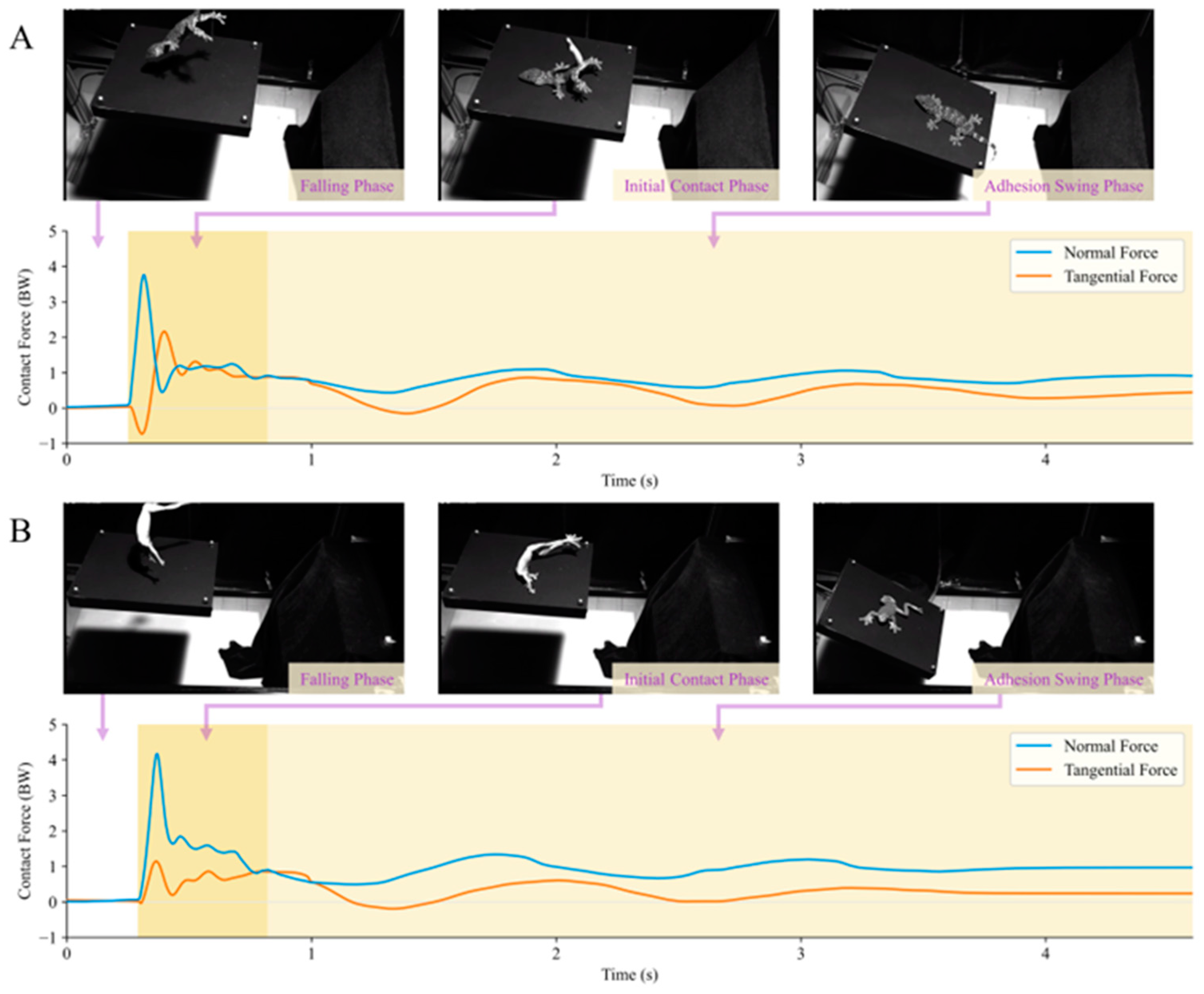
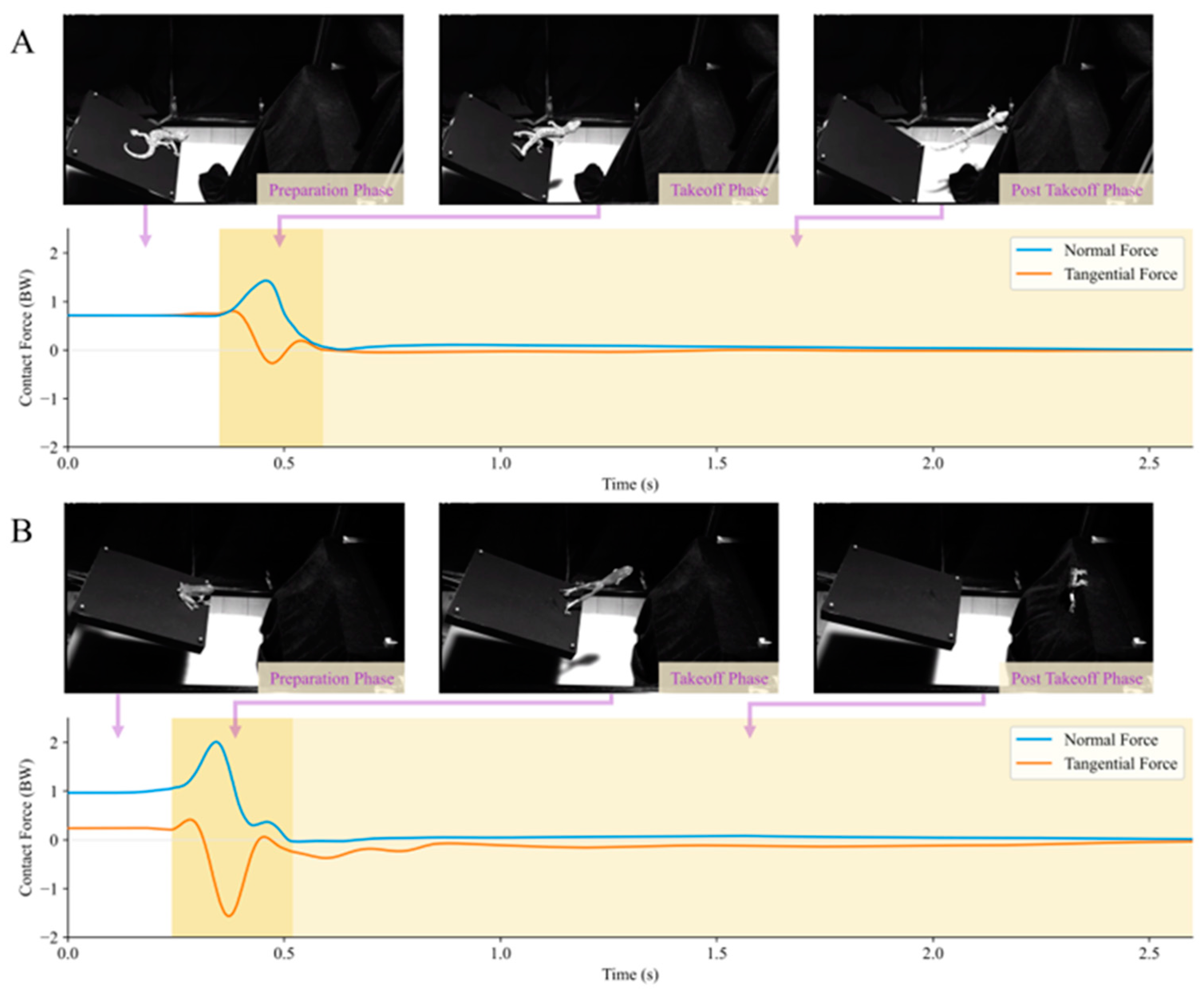
| Comparison Items | Device for Primate Research [26] | Device for Gibbon Research [11] | Device for Tree Frog Research [10] | Device in This Research |
|---|---|---|---|---|
| Control of substrate compliance | Stiffness | Stiffness | Stiffness | Stiffness, damping |
| Measurement of contact forces | Normal force | Normal force, tangential force | Normal force | Normal force, tangential force |
| Consideration of inertial forces due to compliant substrate oscillation | No | No | No | Yes |
Disclaimer/Publisher’s Note: The statements, opinions and data contained in all publications are solely those of the individual author(s) and contributor(s) and not of MDPI and/or the editor(s). MDPI and/or the editor(s) disclaim responsibility for any injury to people or property resulting from any ideas, methods, instructions or products referred to in the content. |
© 2024 by the authors. Licensee MDPI, Basel, Switzerland. This article is an open access article distributed under the terms and conditions of the Creative Commons Attribution (CC BY) license (https://creativecommons.org/licenses/by/4.0/).
Share and Cite
Wang, Z.; Feng, Y.; Wang, B.; Yuan, J.; Zhang, B.; Song, Y.; Wu, X.; Li, L.; Li, W.; Dai, Z. Device for Measuring Contact Reaction Forces during Animal Adhesion Landing/Takeoff from Leaf-like Compliant Substrates. Biomimetics 2024, 9, 141. https://doi.org/10.3390/biomimetics9030141
Wang Z, Feng Y, Wang B, Yuan J, Zhang B, Song Y, Wu X, Li L, Li W, Dai Z. Device for Measuring Contact Reaction Forces during Animal Adhesion Landing/Takeoff from Leaf-like Compliant Substrates. Biomimetics. 2024; 9(3):141. https://doi.org/10.3390/biomimetics9030141
Chicago/Turabian StyleWang, Zhouyi, Yiping Feng, Bingcheng Wang, Jiwei Yuan, Baowen Zhang, Yi Song, Xuan Wu, Lei Li, Weipeng Li, and Zhendong Dai. 2024. "Device for Measuring Contact Reaction Forces during Animal Adhesion Landing/Takeoff from Leaf-like Compliant Substrates" Biomimetics 9, no. 3: 141. https://doi.org/10.3390/biomimetics9030141
APA StyleWang, Z., Feng, Y., Wang, B., Yuan, J., Zhang, B., Song, Y., Wu, X., Li, L., Li, W., & Dai, Z. (2024). Device for Measuring Contact Reaction Forces during Animal Adhesion Landing/Takeoff from Leaf-like Compliant Substrates. Biomimetics, 9(3), 141. https://doi.org/10.3390/biomimetics9030141








